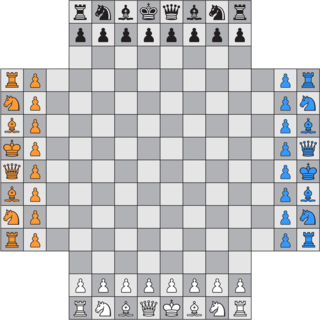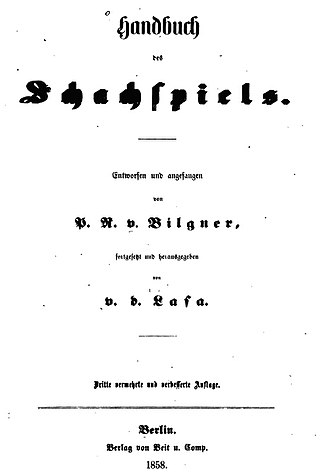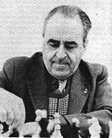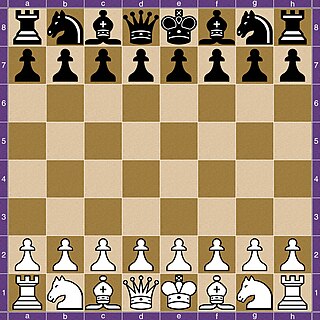Chess libraries are library collections of books and periodicals on the game of chess. In 1913, preeminent chess historian H. J. R. Murray estimated the total number of books, magazines, and newspaper columns pertaining to chess to be about 5,000 at that time. B. H. Wood estimated that number, as of 1949, to be about 20,000. David Hooper and Kenneth Whyld write that, "Since then there has been a steady increase year by year of the number of new chess publications. No one knows how many have been printed..."

Harold James Ruthven Murray was a British educationalist, inspector of schools, and prominent chess historian. His book, A History of Chess, is widely regarded as the most authoritative and comprehensive history of the game.

Howard Staunton was an English chess master who is generally regarded as the world's strongest player from 1843 to 1851, largely as a result of his 1843 victory over Pierre Charles Fournier de Saint-Amant. He promoted a chess set of clearly distinguishable pieces of standardised shape – the Staunton pattern promulgated by Nathaniel Cooke – that is still the style required for competitions. He was the principal organiser of the first international chess tournament in 1851, which made England the world's leading chess centre and caused Adolf Anderssen to be recognised as the world's strongest player.

The New Grove Dictionary of Music and Musicians is an encyclopedic dictionary of music and musicians. Along with the German-language Die Musik in Geschichte und Gegenwart, it is one of the largest reference works on the history and theory of music. Earlier editions were published under the titles A Dictionary of Music and Musicians, and Grove's Dictionary of Music and Musicians; the work has gone through several editions since the 19th century and is widely used. In recent years it has been made available as an electronic resource called Grove Music Online, which is now an important part of Oxford Music Online.

Johann "Hans" Joseph Kmoch was an Austrian-Dutch-American chess International Master (1950), International Arbiter (1951), and a chess journalist and author, for which he is best known.

Alexander Alexandrovich Kotov was a Soviet chess grandmaster and author. He was a Soviet chess champion, a two-time world title Candidate, and a prolific writer on the subject of chess. Kotov served in high posts in the Soviet Chess Federation, and wrote most of his books during the Cold War. The importance and breadth of Kotov's work rank him among the all-time greats in this field.

The Encyclopaedia of Chess Openings (ECO) is a reference work describing the state of opening theory in chess, originally published in five volumes from 1974 to 1979 by the Serbian company Šahovski Informator. It is currently undergoing its fifth edition. ECO may also refer to the opening classification system used by the encyclopedia.
The Dutch Defence is a chess opening characterised by the moves:

The Oxford Advanced Learner's Dictionary (OALD) was the first advanced learner's dictionary of English. It was first published in 1948. It is the largest English-language dictionary from Oxford University Press aimed at a non-native audience. Users with a more linguistic interest, requiring etymologies or copious references, usually prefer the Concise Oxford English Dictionary, or indeed the comprehensive Oxford English Dictionary, or other dictionaries aimed at speakers of English with native-level competence.

Adolf Albin was a Romanian chess player. He is best known for the countergambit that bears his name and for authoring the first chess book written in Romanian.

Four-player chess is a family of chess variants played with four people. The game features a special board typically made of a standard 8×8 square, with 3 rows of 8 cells each extending from each side, and requires two sets of differently colored pieces. The rules are similar to, but not the same as, regular chess. There are a variety of different rule variations; most variations, however, share a somewhat similar board and piece setup.
Checkless chess, also known as prohibition chess, is a chess variant where neither player may give check unless it is checkmate. All other rules are as in regular chess. The origin of the game is unknown, dating from the mid-19th century. The variant is a popular problem theme, usually requiring a fairy mate.
A History of Chess is a book written by H. J. R. Murray (1868–1955) and published in 1913.
The Polish Defense is the name commonly given to one of several sequences of chess opening moves characterized by an early ...b5 by Black. The name "Polish Defense" is given by analogy to the Polish Opening, 1.b4. The original line was

Lev Abramovich Polugaevsky was a Soviet chess player. He was awarded the title of International Grandmaster by FIDE in 1962 and was a frequent contender for the World Championship, although he never achieved that title. He was one of the strongest players in the world from the early 1960s until the late 1980s, as well as a distinguished author and opening theorist whose contributions in this field remain important to the present day.

Handbuch des Schachspiels is a chess book, first published in 1843 by Tassilo von Heydebrand und der Lasa. It was a comprehensive reference book on the game, and one of the most important references on opening theory for many decades. The Handbuch had been the project of Paul Rudolf von Bilguer, who was with von der Lasa a member of the Berlin Chess Club and the influential group of chess masters later called the Berlin Pleiades. Bilguer died in 1840, with the work still in the early stages. Von der Lasa completed the project and saw it published, with his friend von Bilguer alone named as author. It contained comprehensive analyses of all opening variations then known, plus a section on the history and literature of chess.

Yakov Borisovich Estrin was a Russian chess player, chess theoretician, writer, and World Correspondence Chess Champion who held the chess titles of International Master and International Correspondence Chess Grandmaster.

My 60 Memorable Games is a chess book by Bobby Fischer, first published in 1969. It is a collection of his games dating from the 1957 New Jersey Open to the 1967 Sousse Interzonal. Unlike many players' anthologies, which are often titled My Best Games and include only wins or draws, My 60 Memorable Games includes nine draws and three losses. It has been described as a "classic of objective and painstaking analysis" and is regarded as one of the great pieces of chess literature.

The game of chess is commonly divided into three phases: the opening, middlegame, and endgame. There is a large body of theory regarding how the game should be played in each of these phases, especially the opening and endgame. Those who write about chess theory, who are often also eminent players, are referred to as "theorists" or "theoreticians".

Libro de la invencion liberal y arte del juego del axedrez is one of the first books published about modern chess in Europe, after Pedro Damiano's 1512 book. It was written by Spanish priest Ruy López de Segura in 1561 and published in Alcalá de Henares.















